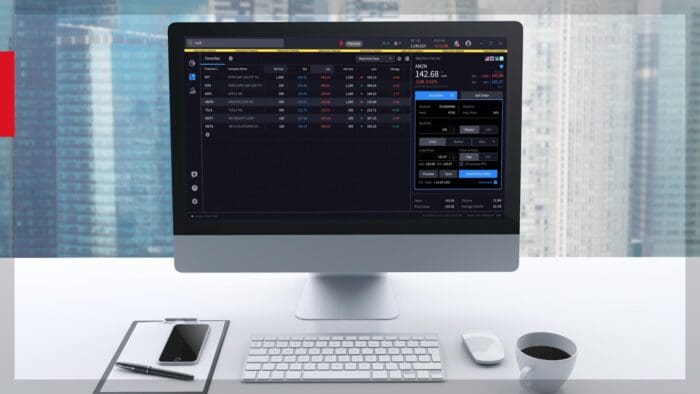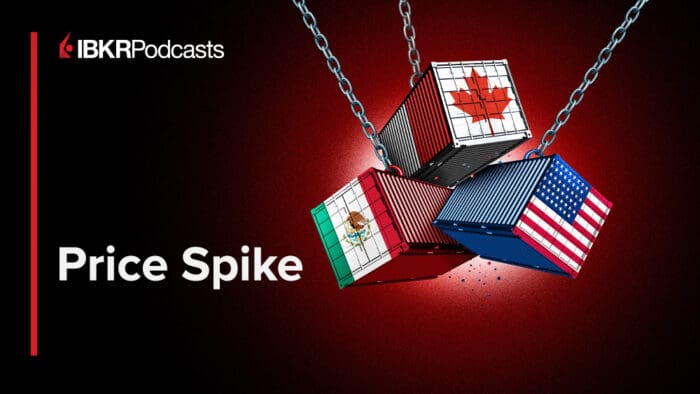Markets are on edge as tariffs, inflation, and job data create a whirlwind of uncertainty. Join Andrew Wilkinson, Steve Sosnick, and Jose Torres as they dissect the latest economic shifts, political curveballs, and what it all means for your portfolio
Summary – IBKR Podcasts Ep. 225
The following is a summary of a live audio recording and may contain errors in spelling or grammar. Although IBKR has edited for clarity no material changes have been made.
Andrew Wilkinson
Welcome to our monthly economics and markets edition of this IBKR podcast. I’m your host, Andrew Wilkinson. Joining me today are Steve Sosnick, Chief Market Strategist, and Jose Torres, Senior Economist. Welcome, both of you.
Steve Sosnick
Great to see you, Andrew. Great to see you, Jose. Happy day after the Super Bowl to both of you.
Jose Torres
Hi Steve. Hi Andrew.
Andrew Wilkinson
Jose, let’s come to you first. The unemployment rate in January fell to 4% in an unexpected turn of fate. What are the key takeaways from you on the January employment report?
Jose Torres
We’ve seen easing pressures, declining unemployment, and favorable revisions over the past two months. However, this month’s data revealed narrow roster expansions. One key component of the jobs report—the average hourly workweek—fell to 34.1 hours, the lowest since March 2020 during the pandemic. Before that, you’d have to go back to 2010 to find a similarly low figure.
So what does the average hourly workweek tell us? Historically, employers tend to reduce hours before trimming their labor force. They might move full-time workers to part-time status or cut hours for part-timers.
Additionally, there were some signs of weakness in the report. Most of the gains came from private education, health services, and government—three non-cyclical sectors. In the cyclical sectors, retail and other services were the only areas contributing meaningfully. Sectors like finance, construction, manufacturing, wholesale trade, information, transportation, and warehousing added very few jobs, ranging between 100 and 8,000. Meanwhile, leisure and hospitality, mining, and professional and business services saw job losses.
Overall, despite strong wage growth and a good headline number, the composition of job growth was narrow and not particularly buoyant. The drop in the average workweek was an unwelcome surprise.
Steve Sosnick
If I may, Jose, two points stood out to me. First, average hourly earnings rose by 0.5% when 0.3% was expected, yet hours worked declined. That seems like living the dream—getting paid more to work less! How do we reconcile these two factors?
Second, the government showed employment growth, but that might reverse in the next report. How much could that weigh on the numbers going forward?
Jose Torres
We could see a 20,000-job drag from government employment in the coming reports, which could weigh on payroll growth.
As for reconciling the decline in hours worked with wage pressures, I think leisure and hospitality plays a key role. That sector has been decelerating and is prone to cutting hours. Bartenders, waitstaff, and similar roles are known for this. I believe this is happening in discretionary spending categories, while other areas continue to see robust paycheck growth due to higher costs, elevated interest rates, and reduced credit availability.
Andrew Wilkinson
Let’s switch gears and discuss politics. Last week, there were announcements about tariffs. The market initially tumbled but later rebounded. Are we out of the woods politically? What might drive the market decisively up or down from here?
Steve Sosnick
The problem with tariffs right now is the inconsistent messaging. The market isn’t sure what to expect. As we’re taping this on Monday morning, we’re seeing a bit of a relief rally. On Friday, the president hinted at bilateral tariffs, possibly as soon as that day.
But this morning, there are steel and aluminum tariffs, though not in the form we expected. Eventually, the market might begin to feel like it’s facing “the boy who cried wolf.” If threats aren’t followed by significant action, people may start ignoring them.
So far, we’ve seen tariffs on steel, aluminum, and some Chinese goods. China responded with targeted measures that didn’t disrupt the market much. Tariffs on Canada and Mexico were postponed. If these threats continue without major actions, the market may become desensitized. However, the ongoing back-and-forth remains a source of uncertainty, preventing full recoveries after market declines.
Andrew Wilkinson
Steve, I’ll circle back to you on inflation. But first, Jose, we have inflation data coming out this week. How important is it, especially considering January’s labor market report?
Jose Torres
From a monetary policy perspective, I don’t expect this week’s CPI and PPI reports to move the market significantly. January’s price pressures were tame based on nowcasting tools. However, if the data comes in above expectations, it could raise concerns about goods price uncertainty related to tariffs.
That said, as Steve mentioned, both market participants and investors seem fatigued by tariff talk. In terms of broader policy, the Treasury Department has been more disciplined. Treasury Secretary Besant’s efforts to limit spending and balance the budget incrementally have helped cap bond yields and spur a bond market rally. This gives the administration more breathing room on trade negotiations and inflation risks from tariffs and restrictive immigration policies.
Steve Sosnick
Jose, Treasury Secretary Besant put a damper on one of our best podcasts—the one you arranged with Drs. Muran and Roubini. They discussed how the Treasury was depressing interest rates by issuing too many short-term notes instead of longer-term ones. The implication was that Besant agreed with their assessment. However, the Treasury ultimately maintained its focus on managing the long end of the curve without Fed intervention.
This has contributed to the recent relief rally, as fears of more supply and higher yields in the long end didn’t materialize.
Jose Torres
Steven, that’s true. If the Treasury were to issue more long-term debt, it could spike yields, which the former administration tried to avoid. In 2023, we saw that a 10-year Treasury yield above 5% was psychologically painful—not just for equity investors but also for homebuyers and consumers financing major purchases.
Andrew Wilkinson
Steve, it’s one thing for Besant to focus on 10-year bonds, but that hinges on anchoring inflation expectations. Last week’s University of Michigan consumer sentiment survey suggested that the administration’s honeymoon period might be over. What stood out to you in that survey?
Steve Sosnick
It wasn’t encouraging. Inflation expectations spiked, even though gas prices didn’t seem to be the cause. The survey revealed a political divide—Democrats reported significantly worse expectations, while Republicans and independents didn’t change much.
This drop in consumer sentiment, combined with tariff talk, likely contributed to Friday’s market decline. Despite a solid jobs report, these factors unsettled investors.
Andrew Wilkinson
Jose, what are forecast traders expecting for this week’s CPI?
Jose Torres
Forecast traders are aligned with Wall Street’s consensus: a 2.9% year-over-year increase and a 0.3% month-over-month rise for headline CPI. Core inflation is expected to be 3.1% year-over-year and 0.3% month-over-month.
The Fed seems comfortable with 3% inflation, which is positive for equities because it means less tightening. However, if inflation climbs above 4%, the Fed will have to act, creating risks—especially from potential tariff and immigration policies. That said, domestic policies and measures from the Treasury Department are helping to counter those risks.
Andrew Wilkinson
Jose, thanks for joining me today.
Jose Torres
My pleasure. Thank you.
Andrew Wilkinson
Steve, thanks for being here.
Steve Sosnick
My pleasure, as always, Andrew. Great to see you both.
Andrew Wilkinson
And to our audience, don’t forget to subscribe to our channel wherever you download your podcasts.
Join The Conversation
For specific platform feedback and suggestions, please submit it directly to our team using these instructions.
If you have an account-specific question or concern, please reach out to Client Services.
We encourage you to look through our FAQs before posting. Your question may already be covered!
Leave a Reply
Disclosure: Interactive Brokers
The analysis in this material is provided for information only and is not and should not be construed as an offer to sell or the solicitation of an offer to buy any security. To the extent that this material discusses general market activity, industry or sector trends or other broad-based economic or political conditions, it should not be construed as research or investment advice. To the extent that it includes references to specific securities, commodities, currencies, or other instruments, those references do not constitute a recommendation by IBKR to buy, sell or hold such investments. This material does not and is not intended to take into account the particular financial conditions, investment objectives or requirements of individual customers. Before acting on this material, you should consider whether it is suitable for your particular circumstances and, as necessary, seek professional advice.
The views and opinions expressed herein are those of the author and do not necessarily reflect the views of Interactive Brokers, its affiliates, or its employees.
Disclosure: Forecast Contracts
Forecast Contracts are only available to eligible clients of Interactive Brokers LLC, Interactive Brokers Canada Inc., Interactive Brokers Hong Kong Limited, Interactive Brokers Ireland Limited and Interactive Brokers Singapore Pte. Ltd.
Disclosure: ForecastEx
Interactive Brokers LLC is a CFTC-registered Futures Commission Merchant and a clearing member and affiliate of ForecastEx LLC (“ForecastEx”). ForecastEx is a CFTC-registered Designated Contract Market and Derivatives Clearing Organization. Interactive Brokers LLC provides access to ForecastEx forecast contracts for eligible customers. Interactive Brokers LLC does not make recommendations with respect to any products available on its platform, including those offered by ForecastEx.

















Trumpflation is back. Most likely it becomes stagflation as high rates, high prices, tight labor markets, uncertainty over policy all impact investment and demand. Tough talk by Trump will likely have little impact on negotiations as everyone knows his play book. Additionally, currency fluctuations will offset most of any tariffs implemented on a country, hurting US exports instead of reducing imports.